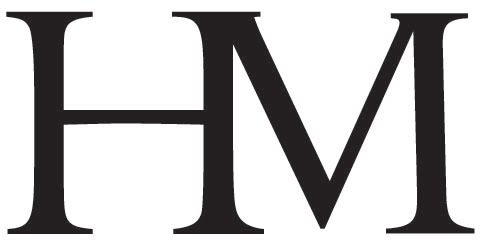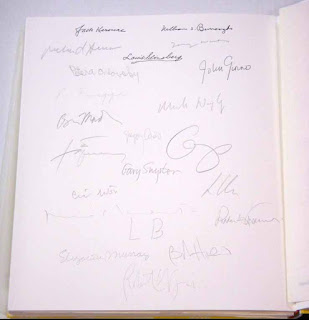If asked, Harold Budd describes himself first as a composer, and only second as a performing musician.
One of HM’s founding goals was to work with people - typically visual artists - interested in creating books, but not already working in that realm. That goal, and an introduction through musician Keith Lowe, is how HM connected with Harold Budd and his poetry. I can’t recall how I was first introduced to his arabesque drawings, but that opened the door for experimenting with printmaking, which Harold was game to try. For the deluxe edition of our first collaboration, Colorful Fortune, we experimented with printing photo-engravings of his original drawings. The chapbook “4” and the Carnival portfolio took the next logical step, presenting original copperplate engravings (i.e. intaglio prints) by Harold - he did them directly on the plates with a needle, and we etched and printed them in Vancouver. For Aurora Teardrops, I asked him to create eight new arabesque drawings to be included throughout the book; these are being printed as line engravings (a relief process). I also (finally) talked him into letting me print one of his scores.
All of this is a précis to this week’s post, something that’s been an interest of mine: printmaking and similar visual experiments by composers and musicians.
John Cage’s interest in printmaking and graphics is well known. He experimented with printmaking at San Francisco’s Crown Point Press, including setting fire to things. Some of his prints are still available, and you can see (buy) them here but not for cheap. A number of his books present his mesostic texts, but no one seems to have used these as a basis for anything more than a standard trade publication. The only limited edition of his that I’ve been able to find is Mud Book, a (not terribly interesting) youthful collaboration with the artist Lois Long published in an edition of 500 copies in 1983 (and subsequently published in a trade edition). Despite the relatively large edition, the signed copy is uncommon; I can’t find one offered at the moment, and the most recently catalogued copy I found (2007) was $1,500. Granary published a book called Nods in a very small edition, but it seems more an “inspired by” project than an actual book by/with Cage. Good luck finding a copy.
Brian Eno was a painter who started making music, and he has continued creating visual art throughout his career (perhaps most famously his 77 Million Paintings). His 2010 a deluxe edition of his album Small Craft on a Milk Sea was issued, with an original screenprint (not a reproduction: similar to come of his strategies for working in a recording studio, he used a small number of screens to create different visual combinations). That project seems to have got him on a printmaking kick: he created more than a dozen silkscreen prints over the next few years, & it looks like he was using the same process of playing with different screens to build up an image. The prints were issued to coincide with installations, but are also available from his online gallery.
But he hasn’t really played around with creating a book in the same way. The only real “limited edition” book with his name attached that I know of is More Dark Than Shark (discussed in this old post). Chronicle should have done something fun with a few hundred copies of Visual Music (I told you all to buy a copy when you had the chance), but like More Dark… that isn’t technically a book by Eno. He has issued a few different editions of his Oblique Strategies cards over the years, but none of the ones I’ve seen look especially lovely. So, as far as we know, no Eno livre d’artiste to date.
Genesis, in the UK, has established a reputation for publishing elaborate limited-edition books by and with (rock) musicians (mostly ones who emerged in the '60s and early '70s, maybe because that’s the age demographic with the interest and cash to buy the books). They seem well produced, but they’re still just commercial coffee-table books printed offset. Not better or worse, but distinctly different than a book produced letterpress, by hand.
Over in Paris First Third Books is mining a similar musical vein, but with the generation that followed Bowie & the Stones. Again, interesting looking, but still commercially/mechanically produced.
Steering back toward composers, pre-1900 most of the printed materials by or related to composers were scores. Above is a nice little two-page Beethoven doodle. I know of a few interesting books from the first half of the last century. Random House issued a limited edition of the score for Porgy & Bess in 1935, signed by the Gershwin. From pictures it looks like a lovely production (especially the binding), but maybe not easy to find in good condition. Merle Armitage published a tribute to Arnold Schoenberg in 1937, and there 50 special copies signed by the composer, but there's nothing terribly remarkable about the book itself. The most interesting thing I can find from Steve Reich is a facsimile of his score for Drumming, issued in 1972 with two vinyl recordings, limited to 500 copies.
Philip Glass published a sort-of musical autobiography in 1987 (Music By Philip Glass). There was a signed edition of 250 copies issued with a laid-in facsimile page from his score for Akhnaten, but it’s just a trade book tarted up. A more interesting publication is the record of his Einstein On The Beach collaboration with Robert Wilson, published in trade & limited editions by Editions Dilecta. Copies of the limited edition (40 for sale) still seem to be available (at 1,200 Euros), but you’re limited to a maximum of two. And again, it’s really just a well-made trade book, not something created entirely by hand.
AH Allen is an interesting project that involved a number of musicians and composers, including Glass (& Joe Strummer!). It was a tribute to Allen Ginsberg, with contributions by over 40 of his peers and friends. This is what I’m talking about when I use the phrase livre d’artiste: it was set in metal type and printed letterpress by Leslie Miller, beautifully hand-bound by Claudia Cohen, and issued in an edition of just 200 copies signed by the contributors (a lotta signatures). Beyond the content, the book was an expression of fine bookmaking, both in materials and execution. (There are three copies offered online right now, starting at $6,000. I know of a copy going for about half that, if you’re interested…)
So that’s a brief tour through contemporary publishing by and with composers and musicians. Lots of the books seem to be little more than a signature added to a regular (& often indifferently designed & printed) hardcover. Eh. Aurora Teardrops, on the other hand, was created in deep collaboration with Harold and Jane Maru over the past three years. We explored a number of different design ideas and formats, working toward something that fully exploits the technical and artistic opportunities that doing everything by hand offers. Printing & binding the edition will take over 2,000 hours of labor (contrary to what the prices might suggest, no one gets into this for the money; the guiding principle at HM for these kinds of collaborations is, we’ll all be equally underpaid). The first newsletter to subscribers will go out soon, with details for pre-ordering. Of the 26 deluxe copies, only 20 will be offered for sale; 40 of the 50 regular copies will be offered. A limited number of copies from each issue will be available at a discounted price for pre-order. Details to follow...













